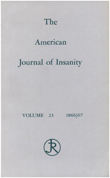Predicting patterns of sexual acts among homosexual and bisexual youths
Abstract
OBJECTIVE: This longitudinal study examined predictors of patterns of change in HIV sexual risk acts among homosexual and bisexual adolescent males. METHOD: A consecutive series of 136 homosexual and bisexual males aged 14-19 years were recruited into the study. Subjects were predominantly Hispanic (51%) and African American (31%) and seeking services at a homosexual-identified community-based agency in New York City. All subjects participated in an intensive HIV intervention program. Patterns of change in HIV sexual risk acts were based on assessments at four points (intake and 3, 6, and 12 months later) and were used to classify youths as demonstrating one of five patterns of anal and oral sexual acts: protected (anal: 45%, oral: 25%), improved (32% and 28%, respectively), relapse (5% and 8%), variable (8% and 15%), and unprotected (10% and 24%). Components of the health belief, self-efficacy, peer influence, coping, and distress models were assessed as predictors of these patterns. RESULTS: Protected and improved patterns of sexual risk acts were associated with low levels of anxiety, depression, and substance use and high self-esteem. CONCLUSIONS: These data suggest that HIV interventions must address non- HIV-related issues confronting youths in difficult life circumstances, particularly emotional distress and the role of peer networks for homosexual and bisexual youths.
Access content
To read the fulltext, please use one of the options below to sign in or purchase access.- Personal login
- Institutional Login
- Sign in via OpenAthens
- Register for access
-
Please login/register if you wish to pair your device and check access availability.
Not a subscriber?
PsychiatryOnline subscription options offer access to the DSM-5 library, books, journals, CME, and patient resources. This all-in-one virtual library provides psychiatrists and mental health professionals with key resources for diagnosis, treatment, research, and professional development.
Need more help? PsychiatryOnline Customer Service may be reached by emailing [email protected] or by calling 800-368-5777 (in the U.S.) or 703-907-7322 (outside the U.S.).



